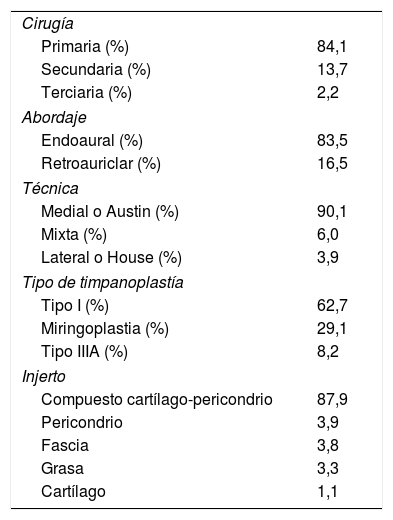La timpanoplastia es una cirugía frecuente en otorrinolaringología. Su mayor indicación es la perforación timpánica, y con menor frecuencia la otitis adhesiva. Su objetivo primario o anatómico es restaurar la integridad timpánica, previniendo infecciones, y secundario o auditivo es preservar o mejorar la audición.
Material y métodoEstudio retrospectivo de los pacientes operados de timpanoplastia en nuestro hospital. Se registraron características biodemográficas, de la patología del oído, de la cirugía y se analizaron los resultados anatómicos y auditivos.
ResultadosSe incluyeron 182 pacientes, la mayoría de sexo femenino (57,1%), edad promedio de 36,1 años. La principal indicación fue la perforación timpánica (89,0%), seguida de otitis adhesiva (7,1%). La mayoría de las timpanoplastias correspondió a cirugía primaria (84,1%), tipo I (62,6%), por abordaje endoaural (83,5%) y técnica medial o Austin (90,1%). El injerto más utilizado fue el compuesto de cartílago-pericondrio (87,9%). El éxito anatómico fue 84,6% y el auditivo 66,8%. Los pacientes operados de miringoplastia (sin elevación de colgajo timpanomeatal) presentaron mejor resultado auditivo (p=0,003). No se identificaron factores asociados a mejor resultado anatómico.
ConclusionesLos resultados anatómicos y auditivos obtenidos son comparables a lo publicado en la literatura. Se requieren más estudios prospectivos para definir factores asociados a un mejor resultado anatómico y auditivo.
Tympanoplasty is a frequent surgery in otolaryngology. Its main indication is tympanic perforation, followed by adhesive otopathy. Its main and (or) anatomic objective is to restore the tympanic membrane's integrity, preventing infections, and its secondary or audiometric objective is to preserve or improve hearing.
Material and methodRetrospective study of all patients submitted to tympanoplasty at our hospital. Biodemographic, ear pathology and surgery characteristics were registered, and anatomic and audiometric success rates were analyzed.
ResultsA total of 182 patients were included, most female (57.1%), with average age of 36.1 years. The main surgical indication was tympanic perforation (89.0%), followed by adhesive otopathy (7.1%). Most tympanoplasties were primary surgeries (84.1%), type I (62.6%), performed by endoaural approach (83.5%) using medial or Austin technique (90.1%). Compound cartilage-perichondrium grafts were most frequently used (87.9%). The anatomic success rate was 84.6%, and the audiometric success rate was 66.8%. Patients who underwent myringoplasty (without raising of tympanomeatal flap) presented a better audiometric result (p=.003). No factors associated with better anatomical results were identified.
ConclusionsOur anatomic and audiometric results are comparable to those previously published. Further prospective studies are required to define factors associated with improved anatomic and audiometric results.











